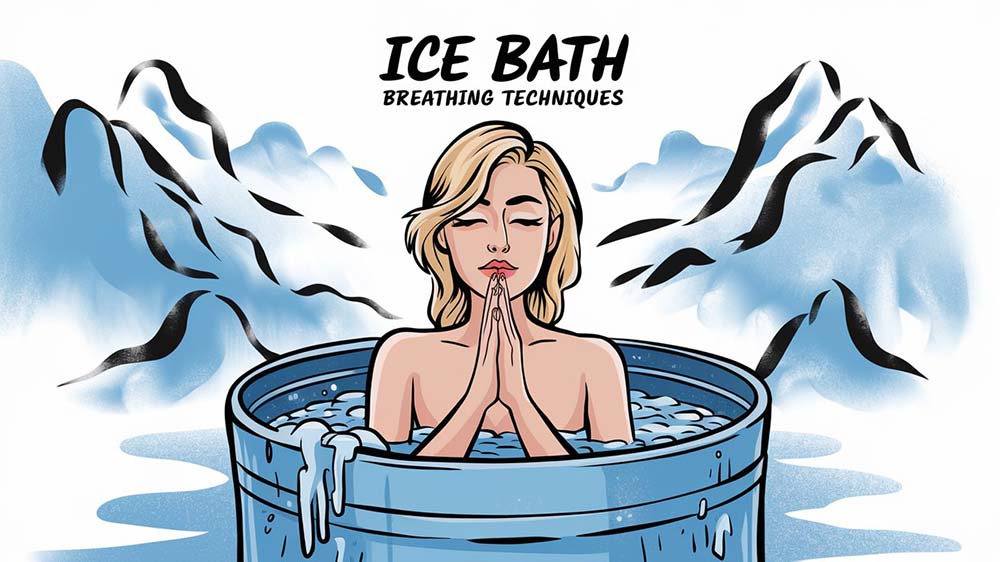Taking an ice bath can be a powerful way to boost your recovery and mental toughness. But let’s face it – jumping into freezing water isn’t easy. That’s where breathing techniques come in handy.
By mastering specific breathing techniques, you can significantly enhance your ice bath experience. Controlled breathing helps regulate your body’s stress response, potentially reducing the initial shock of cold immersion. It can also improve your ability to stay in the cold water longer, allowing you to fully benefit from the therapy.
Moreover, focused breathing practices can shift your mindset, transforming the ice bath from a mere physical challenge into a meditative experience that cultivates mental resilience. These techniques not only make the process more comfortable but also optimize the physiological benefits of cold exposure, such as improved circulation, reduced inflammation, and enhanced recovery.
In this guide, we’ll walk you through eight effective breathing methods for ice baths. We cover everything from the intense Wim Hof Method to calming yoga breaths. Each technique is designed to help you stay calm and focused when the cold hits. We’ll also help you figure out which breathing style works best for you, whether you’re new to ice baths or have been doing them for years.
By the end of this article, you’ll have a toolbox of breathing exercises to make your ice baths more manageable and rewarding. Ready to dive in?
Best Ice Bath Breathing Techniques
1. The Wim Hof Method
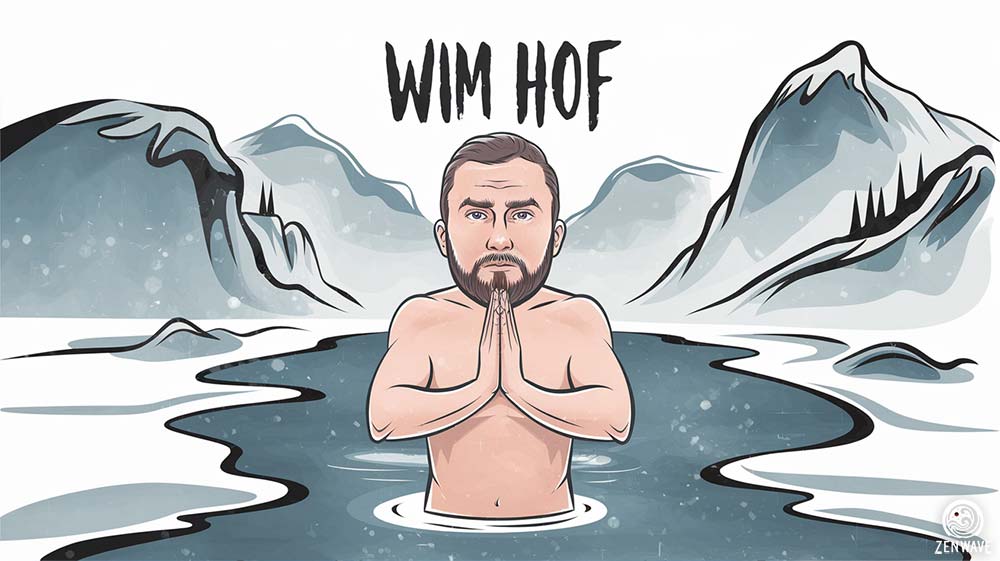
Developed by Dutch athlete Wim Hof, this technique combines controlled hyperventilation with breath retention, designed specifically for cold exposure. It prepares your body physiologically for cold stress by altering blood chemistry and nervous system activity, potentially increasing heat production and reducing the shock response to cold water immersion.
Benefits for ice baths:
- Increases cold tolerance
- Potentially raises body temperature
- Activates sympathetic nervous system
- Enhances mental focus and resilience
Steps:
- Perform 30-40 deep, rapid breaths: Inhale fully through the nose or mouth, then exhale quickly through the mouth. Focus on expanding your chest and belly.
- After final exhale, hold breath as long as comfortable: Exhale fully and resist the urge to breathe for as long as you can.
- Take a deep inhale and hold for 10-15 seconds: Fill your lungs completely and retain the breath.
- Repeat for 3-4 rounds before entering cold water: Complete the cycle several times to maximize the effect.
This technique helps practitioners maintain calm and focus during ice baths, potentially extending cold exposure time and enhancing overall benefits.
2. Tummo Breathing
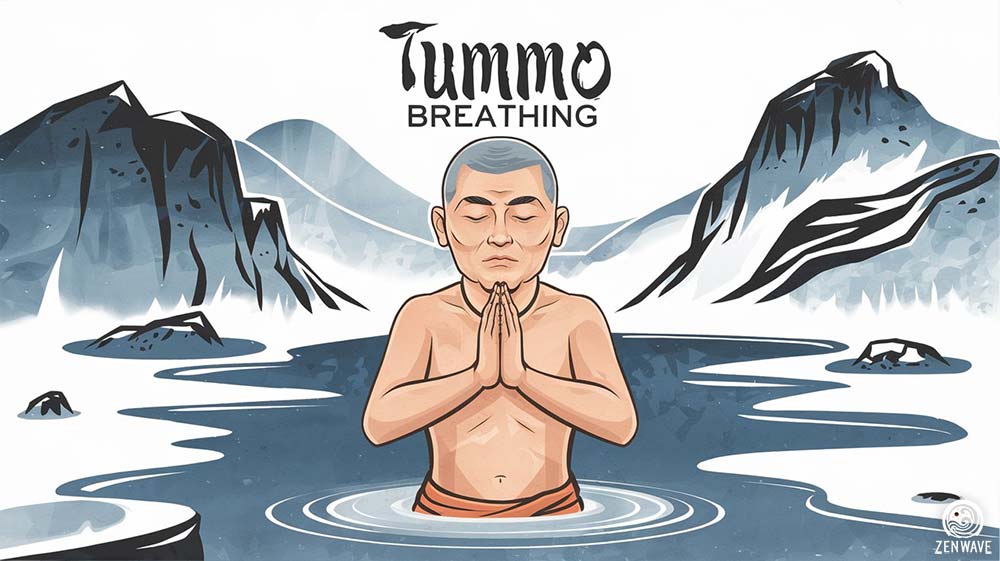
Tummo, or “inner fire” meditation, is a Tibetan technique combining visualization with breath control. It aims to generate internal heat through focused breathing and mental imagery, making it particularly suitable for cold exposure. The practice is believed to stimulate the sympathetic nervous system and increase metabolic rate.
Benefits for ice baths:
- Generates internal heat
- Improves mental focus
- Maintains core body temperature
- Enhances cold tolerance
Steps:
- Take deep, slow breaths: Inhale deeply through your nose, filling your lungs completely.
- Visualize warmth building in your core as you inhale: Imagine a ball of warm light growing in your abdomen.
- As you exhale, imagine directing that warmth throughout your body: Mentally push the warmth to your limbs and extremities.
- Maintain this visualization and breathing pattern during the plunge: Continue the practice throughout your cold immersion.
This method helps practitioners overcome the discomfort of cold immersion by providing a powerful mental focus and potentially increasing physiological resilience to cold stress.
3. Controlled Exhale Technique
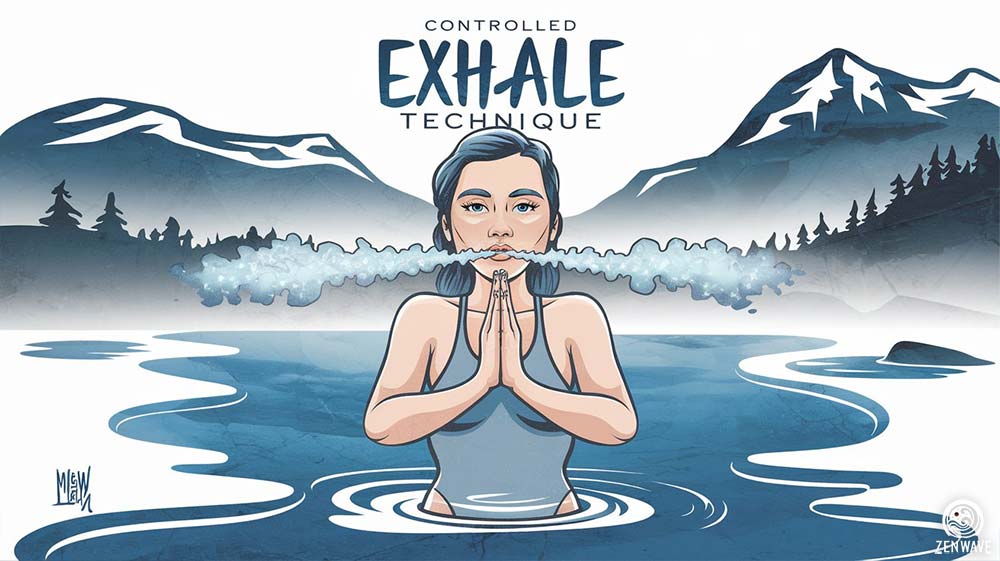
This method focuses on prolonged exhalation to activate the parasympathetic nervous system, promoting a state of calm and relaxation. By emphasizing the exhale, it helps counter the natural tendency to take short, shallow breaths when exposed to cold water.
Benefits for ice baths:
- Lowers heart rate
- Increases calmness
- Reduces stress response
- Improves cold water tolerance
Steps:
- Take a short, quick inhale through your nose: Breathe in sharply but not deeply.
- Exhale slowly and deliberately through slightly pursed lips: Focus on a long, controlled exhale.
- Gradually extend the exhale duration: Aim to make each exhale longer than the previous one.
- Maintain a 1:2 inhale-to-exhale ratio: For example, inhale for 2 seconds, exhale for 4 seconds.
This technique helps manage the initial shock of cold water immersion and promotes a sense of control and relaxation throughout the plunge.
4. Box Breathing

Box breathing, also known as square breathing, is a technique that creates a rhythmic breathing pattern. It’s particularly effective for regulating the nervous system and improving focus, making it valuable for managing the stress of cold water immersion. This technique gained popularity through its use in military and high-stress professions, particularly after being promoted by former Navy SEAL Mark Divine.
Benefits for ice baths:
- Regulates the nervous system
- Improves focus and concentration
- Reduces anxiety and stress
- Provides a mental anchor during discomfort
Steps:
- Inhale for a count of 4: Breathe in slowly and deeply through your nose.
- Hold the breath for a count of 4: Retain the air in your lungs.
- Exhale for a count of 4: Release the breath slowly through your mouth.
- Hold the empty lungs for a count of 4: Pause before beginning the next inhale.
- Repeat this square pattern throughout the plunge: Maintain the rhythm for the duration of your cold exposure.
Box breathing offers a structured approach to breath control, helping to maintain composure and focus during the challenging experience of an ice bath.
5. Deep Diaphragmatic Breathing
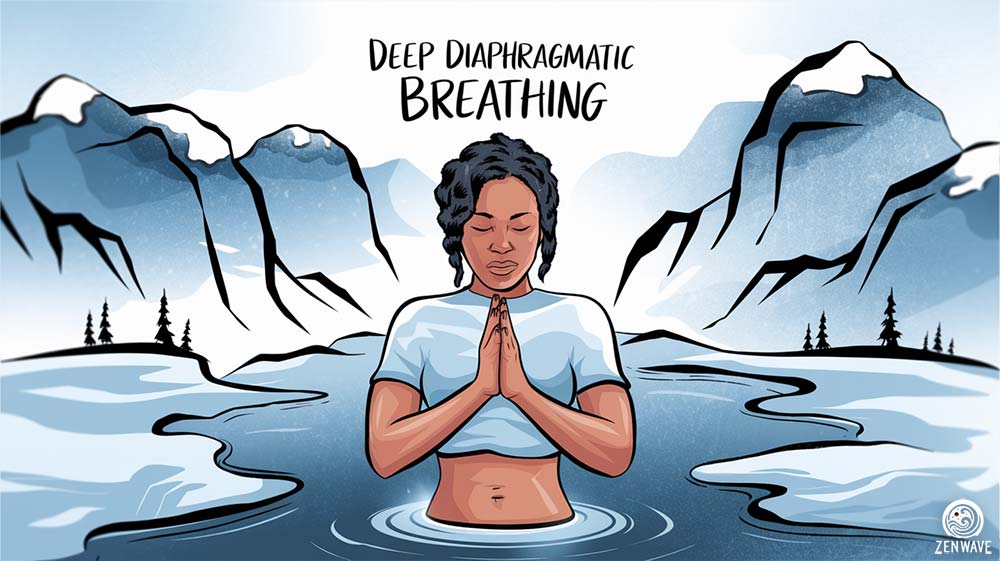
Also known as belly breathing, this fundamental technique focuses on using the diaphragm to take deep, full breaths. It promotes overall relaxation and improved oxygenation, making it an excellent foundational practice for cold water immersion.
Benefits for ice baths:
- Promotes overall relaxation
- Improves oxygenation
- Helps calm the initial shock response
- Enhances body awareness
Steps:
- Inhale deeply through your nose for 3-4 seconds: Focus on expanding your belly rather than your chest.
- Hold the breath briefly: Pause for a moment at the top of your inhale.
- Exhale slowly through your mouth for 4-5 seconds: Let your belly relax and deflate.
- Pause briefly at the end of the exhale: Rest for a moment before beginning the next inhale.
- Repeat this cycle, focusing on slow, controlled breaths: Maintain this pattern throughout your cold plunge.
Deep diaphragmatic breathing provides a simple yet effective way to remain calm and centered during cold water exposure, making it an excellent technique for beginners and experienced practitioners alike.
6. Progressive Relaxation Breathing
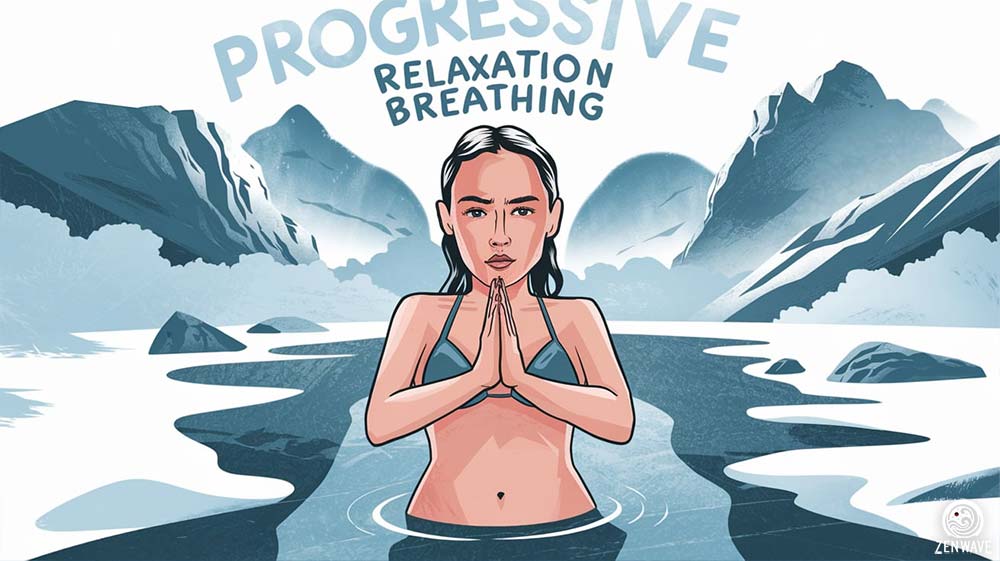
This technique combines breath work with systematic muscle relaxation, helping to counteract the body’s natural tensing response to cold water. It’s particularly effective for maintaining comfort during longer cold plunges.
Benefits for ice baths:
- Reduces muscle tension
- Enhances overall relaxation
- Improves cold tolerance
- Promotes mind-body awareness
Steps:
- Begin with slow, deep breaths: Inhale through your nose for 4 seconds, exhale through your mouth for 6 seconds.
- On each exhale, focus on relaxing a specific body part: Start from your toes and work up to your head.
- Tense the targeted muscle group slightly on inhale: Gently contract the muscles.
- Release the tension completely on exhale: Let the muscles fully relax as you breathe out.
- Progress through your entire body: Repeat the process for each major muscle group.
This method helps maintain a relaxed state during cold exposure, potentially allowing for longer and more comfortable immersions.
7. Rhythmic Breathing
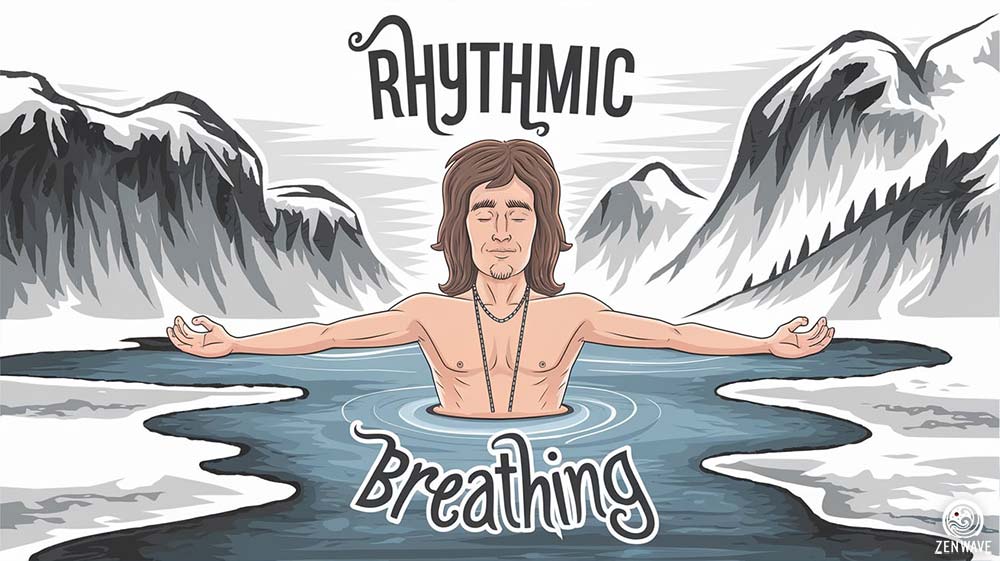
Rhythmic breathing involves synchronizing your breath with physical sensations or mental counting, creating a steady pattern that can help manage the shock of cold water and maintain focus during immersion.
Benefits for ice baths:
- Provides a mental anchor
- Helps manage cold shock response
- Improves focus and concentration
- Enhances mind-body connection
Steps:
- Establish a breathing rhythm before entering the water: For example, inhale for 3 counts, exhale for 3 counts.
- Coordinate your breathing with your movement: Inhale as you lower yourself into the water, exhale as you settle.
- Maintain the rhythm throughout the plunge: Focus on keeping your breath steady and even.
- Adjust the rhythm as needed: Slow down or speed up based on your comfort level.
This technique helps create a sense of control and stability during the challenging experience of cold water immersion.
8. Yogic Alternate Nostril Breathing (Nadi Shodhana)
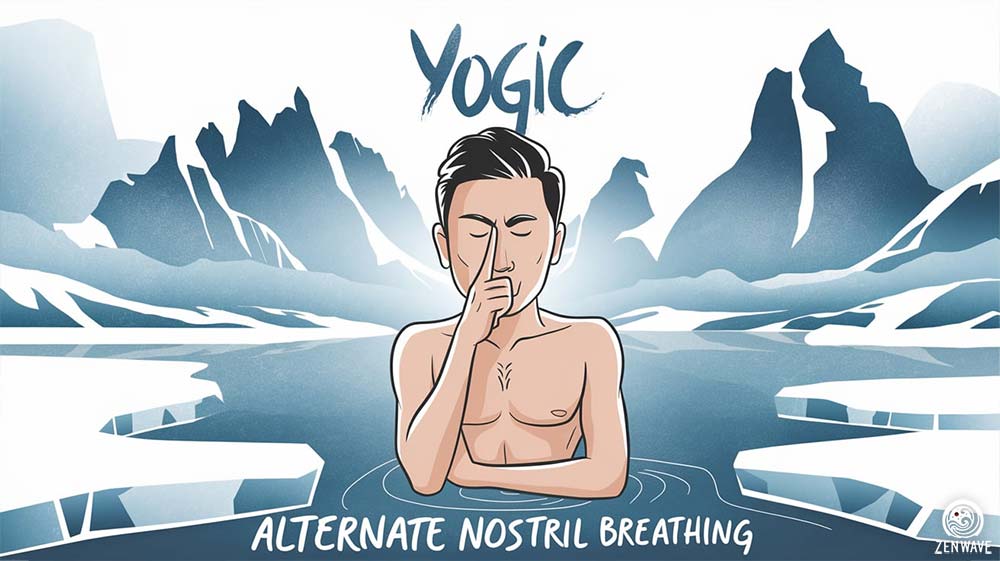
This yogic breathing technique involves alternating breath between the left and right nostrils. It’s believed to balance the nervous system and can be particularly calming before and during cold exposure.
Benefits for ice baths:
- Balances the nervous system
- Reduces anxiety and stress
- Improves focus and mental clarity
- Enhances overall breathing capacity
Steps:
- Sit comfortably and close your eyes: Maintain an upright posture.
- Use your right thumb to close your right nostril: Keep your fingers relaxed.
- Inhale slowly through your left nostril: Breathe in for a count of 4.
- Close your left nostril with your ring finger: Keep both nostrils closed briefly.
- Open your right nostril and exhale slowly: Breathe out for a count of 4.
- Inhale through the right nostril: Breathe in for a count of 4.
- Close the right nostril and exhale through the left: Breathe out for a count of 4.
- Repeat this cycle for several rounds: Aim for 5-10 cycles before and during your cold plunge.
This technique can be particularly effective for calming pre-plunge anxiety and maintaining composure during cold water immersion.
Choosing the Right Ice Bath Breathing Technique
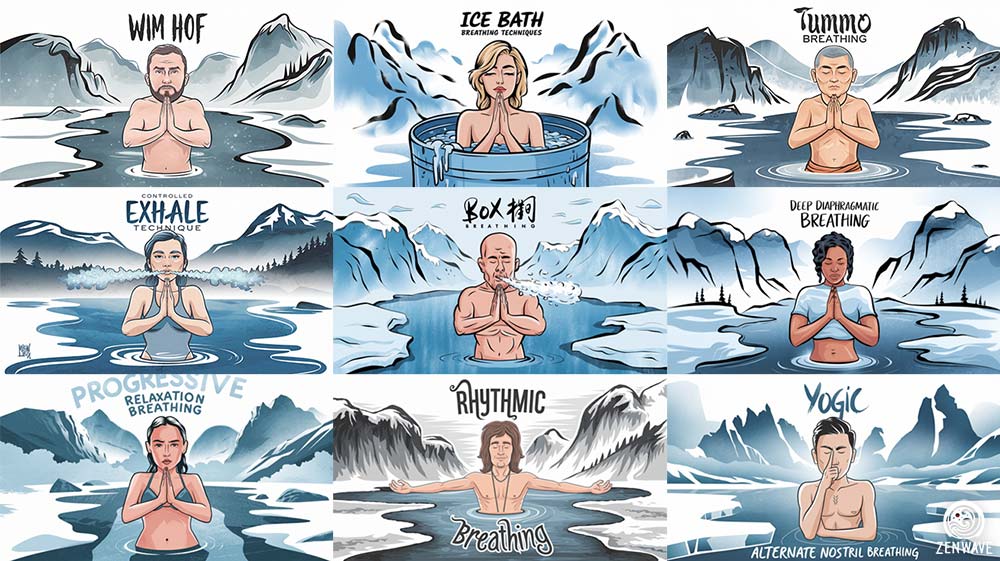
Selecting the ideal breathing technique for your cold plunge practice depends on your experience level, personal preferences, and specific goals.
Beginners might find Deep Diaphragmatic Breathing or Box Breathing easier to start with, as they provide a simple framework for maintaining calm. For those seeking to push their limits, the Wim Hof Method or Tummo Breathing can be more challenging but potentially more rewarding.
If you’re prone to anxiety, the Controlled Exhale Technique or Progressive Relaxation Breathing might be most beneficial. Yogic Alternate Nostril Breathing is excellent for balancing the nervous system before a plunge. Rhythmic Breathing can be particularly helpful if you struggle to maintain focus during cold exposure.
Ultimately, the best approach is to experiment with different techniques and observe how your body responds. You might find that combining elements from various methods works best for you. Remember to practice these techniques in a safe environment before applying them to cold water immersion, and always listen to your body. With time and practice, you’ll discover which technique or combination helps you maximize the benefits of your cold plunge experience.
| Technique | Best For |
|---|---|
| Wim Hof Method | Experienced, pushing limits |
| Tummo Breathing | Advanced, mental focus |
| Controlled Exhale | Anxiety reduction |
| Box Breathing | Beginners, stress reduction |
| Diaphragmatic | Beginners, relaxation |
| Progressive Relaxation | Muscle tension, longer plunges |
| Rhythmic Breathing | Improving focus, consistency |
| Alternate Nostril | Pre-plunge anxiety, balance |
Cold Plunges and Meditation: Enhancing Mind-Body Awareness
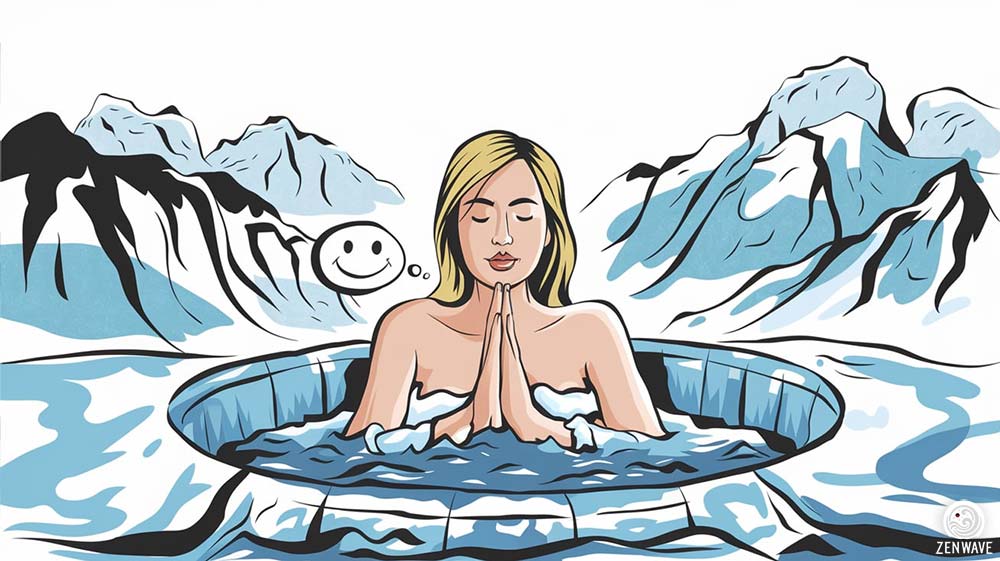
The breathing techniques used for cold plunges share many similarities with meditation practices, making ice baths an excellent opportunity for mindfulness and self-reflection. Here’s how you can integrate meditation into your cold plunge routine and use it to enhance your overall experience:
To use cold plunges as a form of meditation, consider the following approach:
- Set an intention: Before your plunge, take a moment to set a clear intention for your practice.
- Focus on your breath: Use your chosen breathing technique as an anchor for your attention.
- Observe sensations: Notice the physical sensations in your body without judgment.
- Practice presence: Stay fully engaged in the present moment, avoiding thoughts of the past or future.
- Cultivate equanimity: Approach discomfort with a sense of calm acceptance.
To supplement your cold plunge practice with meditation, try these strategies:
- Pre-plunge meditation: Spend 5-10 minutes meditating before your cold plunge to center yourself.
- Post-plunge reflection: After your plunge, take time to sit quietly and reflect on your experience.
- Daily practice: Develop a regular meditation practice to improve your overall mindfulness and stress management.
- Visualization: Use meditation to visualize successful cold plunges, building mental resilience.
- Body scan: Practice body scan meditations to increase your body awareness for cold exposure.
By approaching cold plunges with a meditative mindset and supplementing your practice with regular meditation, you can deepen your experience, improve your cold tolerance, and cultivate greater mind-body awareness. This holistic approach can lead to enhanced benefits your cold plunge practice and your overall wellness routine.
The ZenWave Ice Pod: Enhancing Your Cold Plunge Practice
For those looking to maximize their Zen and fully embrace the benefits of cold therapy, the ZenWave Ice Pod brings cold therapy into your home. This portable ice bath creates a serene space to practice the breathing techniques we’ve explored.
The ZenWave Ice Pod comfortably fits one person and can be used indoors or outdoors, adapting to your space and lifestyle. This flexibility makes it easier to maintain a consistent cold plunge practice, which is key to deepening your experience.
With the ZenWave Ice Pod, you can enjoy:
- Convenient at-home cold therapy
- A controlled environment for breathing practices
- An enhanced overall cold plunge experience
- Support for gradually adapting to cold exposure
When you begin using the ZenWave Ice Pod, start with short sessions in milder temperatures. Try 2-3 minutes at 59°F (15°C). Use this time to focus on your chosen breathing technique, whether it’s the Wim Hof Method, Tummo breathing, or another approach we’ve discussed. As you grow more comfortable, slowly extend your sessions and lower the water temperature. In time, you might work up to 10-15 minute sessions at 5-10°C (41-50°F). Always listen to your body and prioritize your well-being.
Remember to view cold therapy as part of your holistic wellness journey. Combine your ZenWave Ice Pod sessions with the breathing and meditation practices we’ve covered for a well-rounded approach to health and well-being. With regular use and mindful practice, you may find the ZenWave Ice Pod becomes a valuable ally in your path toward greater health, resilience, and inner peace.

